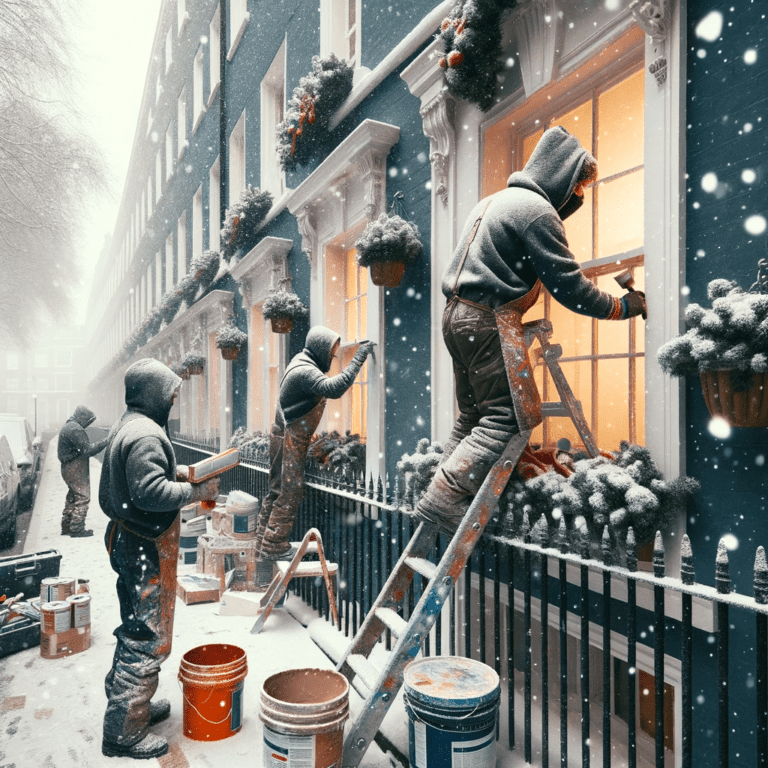Why Winter is the Perfect Time for Painting and Decorating
Table of Contents

Choosing the Right Colors for a Warm and Inviting Ambience
As the temperatures drop and the days get shorter, many people tend to hibernate indoors during the winter months. However, this time of year can be the perfect opportunity to embark on painting and decorating projects in your home. In this section, we will explore why winter is an ideal time for such endeavors, providing you with valuable tips and creative ideas to transform your living space into a cozy haven.
While it may seem counterintuitive to tackle home improvement projects during the colder months, there are several advantages. Firstly, with most outdoor activities put on hold due to inclement weather, you have more time indoors to dedicate to your painting and decorating endeavors. Additionally, many professional painters and decorators have more availability this season, making it easier to schedule their services.
Winter also offers unique opportunities for creating a warm and inviting atmosphere in your home. With colder temperatures outside, you can focus on selecting colors that evoke feelings of warmth and comfort. Whether it’s rich earth tones or soft pastels, choosing the right paint colors can instantly transform a room into a cozy retreat.
Furthermore, winter provides an excellent backdrop for experimenting with different decorating ideas. From layering textures such as faux fur blankets and chunky knit cushions to incorporating seasonal elements like twinkling fairy lights or festive wreaths, there are countless ways to infuse your space with charm and character.
In this section on winter painting tips and decorating ideas, we will delve deeper into specific techniques that work well during this season. We will cover topics such as how to properly prepare surfaces for painting in colder temperatures, selecting paint finishes that withstand changing humidity levels indoors, as well as exploring various cozy home decor trends that are popular during winter.
So please grab a cup of hot tea and join us as we explore why winter is indeed the perfect time for painting and decorating your home. Get ready to transform your living space into a warm and inviting sanctuary you’ll love spending time in during the colder months.
When creating a warm and inviting ambiance in your home, choosing the right colors is critical. Winter color schemes can play a significant role in achieving a cozy interior design that reflects the latest London home decor trends.
Warm paint colors are often preferred for creating a welcoming atmosphere. These hues evoke comfort and relaxation, perfect for living spaces, bedrooms, and dining areas. Shades such as rich browns, deep reds, and earthy oranges can warm a room while maintaining an elegant aesthetic.
Incorporating winter color schemes into your home decor can be done through various elements such as wall paint, furniture upholstery, curtains or drapes, and decorative accents like cushions or throws. By carefully selecting these elements in warm tones that complement each other, you can create a cohesive look that exudes coziness.
London home decor trends often embrace warm color palettes to counterbalance the city’s cooler climate. This includes using shades of cream or off-white as base colors to create a neutral backdrop for warmer accent pieces. Additionally, incorporating natural materials like wood or stone can further enhance the inviting ambiance of any space.
When choosing colors for your home’s interior design during winter months, it is essential to consider both personal preferences and current design trends. By combining warm paint colors with cozy textures and complementary accents, you can achieve an inviting ambiance that is stylish and comfortable.

Prepping Your Walls and Surfaces for Winter Painting
Before embarking on a winter painting project, it is essential to prepare your walls and surfaces properly. This will ensure a smooth and long-lasting finish that can withstand the harsh conditions of the season. In this section, we will explore some critical tips for wall preparation, surface cleaning techniques, and repairing cracks and holes in walls.
To begin with, thorough wall preparation is crucial for a professional-looking paint job. Start by removing loose or peeling paint using a scraper or wire brush. Next, clean the surface using a mild detergent solution and a sponge or cloth to remove dirt, grease, and grime. Pay special attention to areas near stoves or fireplaces where soot may have accumulated.
Once the walls are clean, it’s time to address any cracks or holes that may be present. Use a putty knife to scrape away loose debris from these areas. For small cracks or nail holes, apply an appropriate filler compound using a filling knife or putty knife. Smooth out the filler and allow it to dry completely before sanding it down gently with a fine-grit sandpaper.
For larger cracks or holes in the walls, you may need to use joint compound or plaster for repairs. Apply the compound with a putty knife in thin layers until the damaged area is filled in completely. Allow each layer to dry before applying subsequent coats, and sand down the repaired area until it is smooth and even with the surrounding wall surface.
In addition to repairing cracks and holes, it’s essential to ensure that your walls are free from moisture issues before painting. Check for signs of dampness or water damage, such as peeling paint or discolored patches. If you detect any moisture problems, address them promptly by identifying and fixing the source of water intrusion before proceeding with painting.
By following these wall preparation tips, employing effective surface cleaning techniques, and adequately addressing cracks and holes in your walls before winter painting, you can ensure a durable and visually appealing paint job that will withstand the season’s challenges.
Tackling Moisture and Condensation Issues During Winter Painting
Moisture and condensation can be major challenges when painting during the winter season. However, there are effective ways to tackle these issues and ensure a successful painting project.
One of the critical concerns during winter painting is preventing mold growth. It is essential to control moisture levels in the environment. This can be done by ensuring proper ventilation in the area being painted. Opening windows or using fans can help circulate air and reduce humidity.
Dealing with condensation on walls is another critical aspect of winter painting. Condensation occurs when warm air meets a cold surface, leading to water droplets forming on walls. It is recommended to insulate walls properly and seal any gaps or cracks that may allow cold air to enter.
Using moisture-resistant paints is also essential in preventing moisture-related problems during winter painting. These paints are specially formulated to resist moisture penetration, reducing the chances of mold growth or paint damage.
Additionally, it is advisable to choose a suitable time for painting when temperatures are not too low or fluctuating rapidly. Extreme temperature variations can affect paint adhesion and drying times.
By following these mold prevention tips, dealing with condensation on walls effectively, and using moisture-resistant paints, you can overcome moisture-related challenges during your winter painting projects and achieve long-lasting results.
Embracing Winter-inspired Decorative Elements for a Seasonal Touch
Regarding interior design, embracing winter-inspired decorative elements can bring a seasonal touch to your space. Winter-themed decorations can create a cozy and inviting atmosphere, making your home warm and welcoming during the colder months.
One way to incorporate winter-inspired decor is by using textures and layers. Consider adding plush throws and soft cushions in rich, warm fabrics such as velvet or faux fur. These textures not only add visual interest but also provide comfort and warmth.
Another idea is to incorporate natural elements that are often associated with winter. Consider using pinecones, twigs, or branches in your decor. You can create beautiful centerpieces or wreaths using these elements, bringing a touch of nature indoors.
Additionally, you can play with color schemes that evoke a winter ambiance. Opt for cool tones such as icy blues, crisp whites, or deep grays to create a serene and calming atmosphere reminiscent of snowy landscapes.
By embracing winter-themed decorations and incorporating texture and layers into your interior design, you can transform your space into a cozy retreat during the colder months while adding a touch of seasonal charm.

Protecting Your Furniture and Floors from Paint Spills and Damage
When painting your home, protecting your furniture and floors from paint spills and damage is crucial. Accidental paint spills can lead to unsightly stains and damage that can be difficult to remove or repair. Fortunately, there are various measures you can take to safeguard your furniture and floors during the painting process.
One of the most effective ways to protect your furniture is by covering it with plastic sheets or drop cloths. These protective coverings create a barrier between the paint and your valuable pieces, preventing accidental drips or splatters from causing damage. Additionally, using masking tape around the edges of furniture can further ensure that no paint seeps through.
When it comes to flooring, there are several options available for preventing paint stains on carpets or wooden floors. For carpets, consider using adhesive carpet film or plastic sheeting designed explicitly for this purpose. These products adhere securely to the carpet surface, providing a protective layer that prevents paint from seeping through.
For wooden floors, opt for heavy-duty floor protection materials such as rosin paper or cardboard sheets. These materials shield against paint spills while providing traction for those working there. It’s vital to secure these coverings in place with masking tape or painter’s tape to prevent any movement during the painting process.
In addition to these preventive measures, it’s essential to be cautious and mindful while painting around furniture and on floors. Take extra care when handling brushes or rollers near valuable items, ensuring no accidental contact with surfaces that aren’t meant to be painted.
By implementing these furniture protection strategies and utilizing appropriate floor coverings, you can minimize the risk of paint spills and damage during your painting projects. This will not only preserve the appearance of your furniture and floors but also save you time and money in potential repairs or replacements.